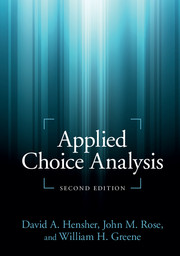Book contents
- Frontmatter
- Contents
- List of Figures
- List of Tables
- Preface
- Part I Getting started
- 1 In the beginning
- 2 Choosing
- 3 Choice and utility
- 4 Families of discrete choice models
- 5 Estimating discrete choice models
- 6 Experimental design and choice experiments
- 7 Statistical inference
- 8 Other matters that analysts often inquire about
- Part II Software and data
- Part III The suite of choice models
- Part IV Advanced topics
- Select glossary
- References
- Index
3 - Choice and utility
from Part I - Getting started
Published online by Cambridge University Press: 05 June 2015
- Frontmatter
- Contents
- List of Figures
- List of Tables
- Preface
- Part I Getting started
- 1 In the beginning
- 2 Choosing
- 3 Choice and utility
- 4 Families of discrete choice models
- 5 Estimating discrete choice models
- 6 Experimental design and choice experiments
- 7 Statistical inference
- 8 Other matters that analysts often inquire about
- Part II Software and data
- Part III The suite of choice models
- Part IV Advanced topics
- Select glossary
- References
- Index
Summary
To call in the statistician after the experiment is done may be no more than asking him to perform a post-mortem examination: he may be able to say what the experiment died of.
(Ronald Fisher)Introduction
As seen in Chapter 2, individual preferences, subject to any constraints faced by those operating in a market, will give rise to choices. These choices in the aggregate sum to represent the total demand for various goods and services within that market. Rather than attempt to model demand based on aggregate level data, discrete choice models seek to model demand using disaggregate level data. Note that this does not necessarily mean that different discrete choice models are estimated for each individual, although some researchers do attempt such feats (e.g., Louviere et al. 2008). Rather, models dealing with aggregate level demand data typically work with variables where each data point represents the amount of some good or service sold at a specific point in time, whereas discrete choice models are typically applied to data where each data point represents an individual choice situation, where the sum of the choices combine to produce information about overall demand.
Importantly, to be able to refer to “demand” we have to allow for the presence of a “no choice,” since some goods and services are not consumed by an individual. Throughout this chapter and the rest of the book, we will refer to both choice and demand, and treat them as interchangeable words. In doing so, we also recognize the broader context within which discrete choice models can be used, that often distinguishes between discrete choice models and a complete system of demand models, the latter at a more aggregate economy wide level, in contrast to discrete choice models that are most commonly applied at a sectoral level (e.g., transport or health). Truong and Hensher (2012), among others, develop the theoretical linkages between discrete choice models and continuous choice models, where discrete choice models focus on the structure of tastes or preferences at the individual level, while continuous demand models can be used to describe the interactions between these preferences at the industry or sectoral level, extendable to an entire economy.
- Type
- Chapter
- Information
- Applied Choice Analysis , pp. 30 - 79Publisher: Cambridge University PressPrint publication year: 2015
- 1
- Cited by

